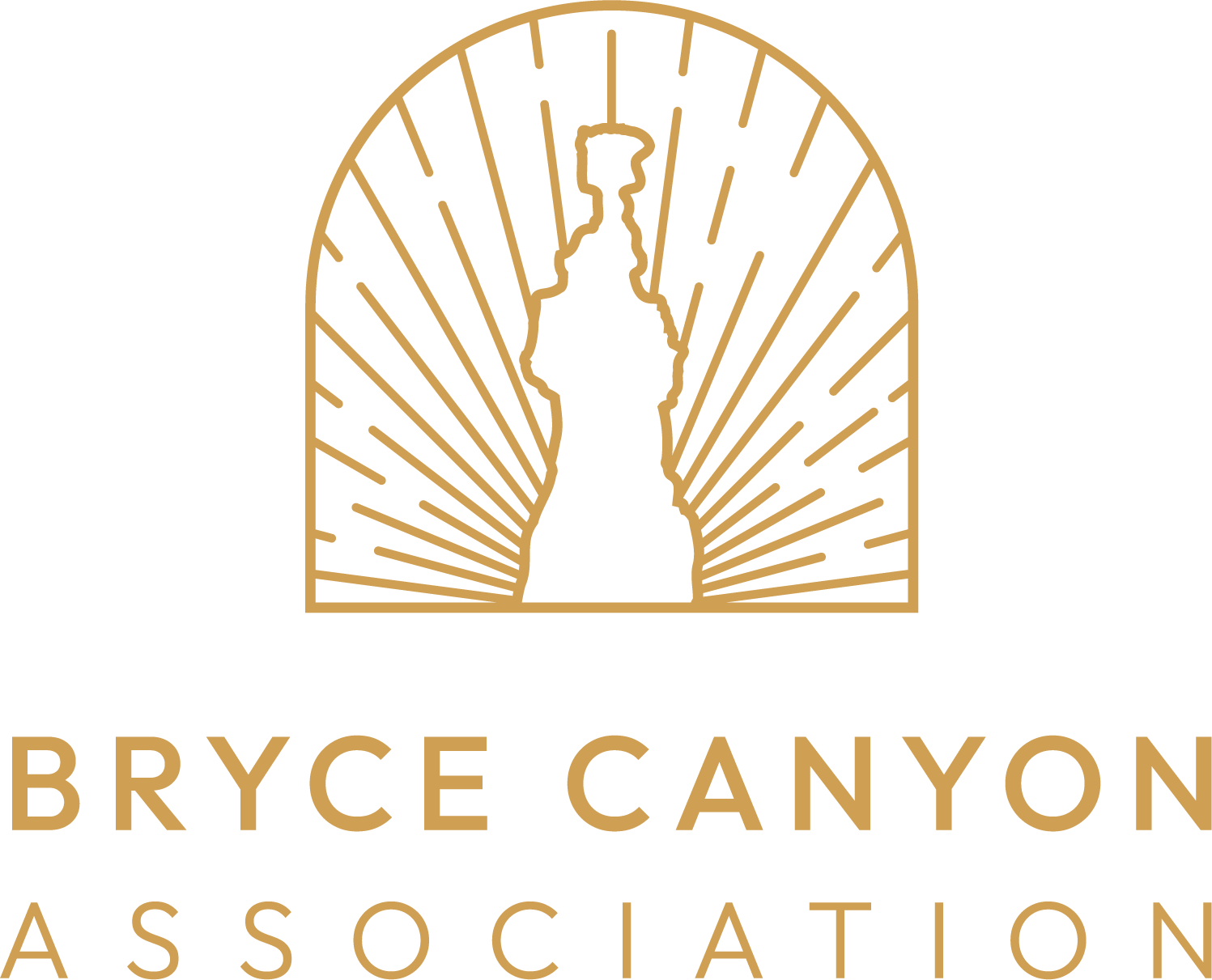
Article by Stephanie Payne, Media Pro – U.S. National Parks and NASA Human spaceflight, Photos by Jonathan Irish
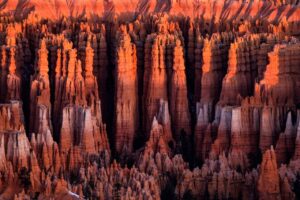
Like many of America’s national parks, Bryce Canyon National Park in Utah has many cool pockets to explore. Nothing compares, though, to the feeling you get when standing before the hoodoos that make up the Bryce Amphitheater.
Bryce Canyon is home to the largest collection of hoodoos on Earth. It is not a canyon at all, actually, but a 6-square-mile field of intricately carved statues that were crafted over the course of millions of years by the forces of erosion. Facing east and south, vast labyrinths of high promontories, deep canyons, jagged spires of balancing rocks, and other mysterious formations are emblazoned by bold colors of red, orange, pink, and white. It is a landscape that is totally unique – entirely different than nearby Zion as well as other Utah national parks – partly attributed to its high elevation location ranging from 8,000-9,000 feet. The air is thinner up there, the environment colder, and the wind much, much stronger – elements that come together to create an otherworld on the edge of the Paunsaugunt Plateau. Stepping onto any lookout, you are challenged to connect with a most amazing example of the forces of nature affecting this planet, and at the same time, you will almost certainly feel as though you are stepping foot onto the edge of another world.
For this article, we want to highlight a few different ideas that will deliver a diverse experience in Bryce – where to stay, hike, auto-tour and capture the best sunrise and sunset views – with the caveat that at this one-of-a-kind national park, there is nothing more spectacular than the red rock nation that sprawls across Utah’s high desert on the Colorado Plateau.
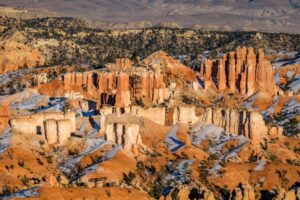
Drive: Hitting the scenic auto-trails in the national parks is often the best place to start to gain an understanding of the lay of the land. Many of the park roads were developed and built by the Civilian Conservation Corps in the early days of the park service in an effort to provide access to the most interesting (and marketable) features nearby. A scenic tour along the 38-mile (round trip) Bryce Canyon National Park Rim Road provides access to 13 viewpoints that peer over the amphitheaters. It is a perfect first outing to get acquainted with the park.
Stay: There are three lodging options located inside of the park: the North Campground (open year-round,) Sunset Campground (high season,) and the recently renovated 114-room Bryce Canyon Lodge, which was built from local timber and stone in 1924-25. Any non-park related activity – be it sleeping, eating, shopping, gassing up, or learning about the local history – will almost surely bring you to Ruby’s legendary roadhouse. The lodge was built in 1919 by Reuben C. (Ruby) Syrett who was so spellbound by the scene at Bryce that he decided to stand up a “tourist rest” where he and his family could host visitors to the area. As the park became more popular, so did Ruby’s – it is an absolute can’t miss in the area (you couldn’t miss it even if you tried!) Everything you need to fuel a park adventure is available there. The operation is still family run – by Ruby’s son Carl, and two generations that follow him.
Wander: A 1-mile walk between Sunset Point and Sunrise Point offers panoramic views of the amphitheater and is suitable for anyone, the only real challenge being that severe weather can cause the paved pathway to ice over during colder months. Each overlook is situated at a trailhead where from you can descend into the hoodoos if you want to explore deeper
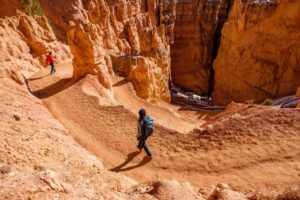
Hike: Standing inside of the amphitheater – even if walking just a short distance into the hoodoos – allows you to become a part of the landscape. The Navajo Loop trail is the park’s most popular hiking trail because of its accessibility and its beauty. Descending first into the Wall Street section, you are thrust upon an iconic scene in the park, a 700-year-old Douglas fir tree that rises in the midst of a slot canyon to search for sunlight in the sky. Traveling farther, you will find a vast network of trails leading into the hoodoos where you can chart your own course.
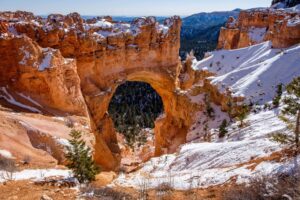
View: An easy stop off of the Bryce Canyon Road brings you to the Natural Bridge, one of several natural arch formations found in the national park. Deeply colored Ponderosa pine trees can be seen peeking out from behind red rock with vista views as a backdrop. The photogenic scene is a must for every photographer visiting Bryce.
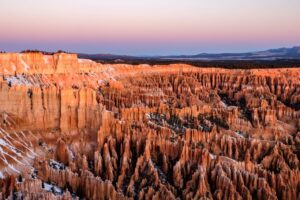
Enjoy the sunset: Sunset Point is usually the first stop on everyone’s list and is a top spot to capture shots of a golden forest of stone. There is no shortage of onlookers capturing selfies and panoramic shots of the amphitheater at this lookout, but you’ll likely find yourself distracted only by the geologic wonder surrounding the scene. This area is called the Claron Formation, made up of deposits from the Claron lakebed comprised of 50-million-year-old limestone that shows rich and vibrant color – especially under the sun – created by its iron oxide mineral compounds. Whether you are intrigued by geol
ogic processes or just want to marvel at the area’s undeniable beauty, all visitors stop in their tracks at this famed overlook, particularly when the sun falls onto the canyons.
Capture the sunrise: Bryce Point, facing Sunset Point and just a short drive away, is a truly awesome place to catch the sunrise. The sheer drop on the other side of the chain link fence can be a punch to the gut for those whom fear exposure. The air is thin with altitude, and the wind gusts are extra bone-chilling during the sunrise hours… and the skyline, electrifying. This spot is perfect for photographers as well as those who want to see incredible, extreme landscapes change with the light of the rising sun. Another popular place to watch the sunrise is the aptly named Sunrise Point.
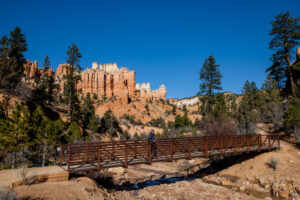 See something different: Mossy Cave is located on State Route 12 northwest of the small town of Tropic, a neat place to stop and wander during high-season when shops and sites are open. The cave itself can be reached taking the left fork on the Mossy Cave trail. When the conditions are optimal, water drip from the cave ceiling creates hanging gardens (during North American Summer) and icicles (North American winter.) It’s a challenge to photograph because the cave and surrounding area is dark, though the setting away from the crowds of the amphitheater are charming and peaceful.
See something different: Mossy Cave is located on State Route 12 northwest of the small town of Tropic, a neat place to stop and wander during high-season when shops and sites are open. The cave itself can be reached taking the left fork on the Mossy Cave trail. When the conditions are optimal, water drip from the cave ceiling creates hanging gardens (during North American Summer) and icicles (North American winter.) It’s a challenge to photograph because the cave and surrounding area is dark, though the setting away from the crowds of the amphitheater are charming and peaceful.
Hug some trees: The forested areas surrounding the national park cross three “life zones” that change with variant elevation gains. In the lower regions you will find dwarf forests (juniper, pinyon pine, manzanita, aspen, willow, and birch) growing along streams. In the mid-elevations, Ponderosa pine, spruce, and Douglas fir forests thrive. On the high plateau, spruce, aspen, and Douglas and white fir continue. At Rainbow Point located at the end of the scenic drive, you can spot the toughest tree on Earth: the ancient Great Basin bristlecone pine, a species categorized among the oldest living organisms on the planet.
Visit the Bryce Canyon Natural History Association web page for your Trip Planning Package
